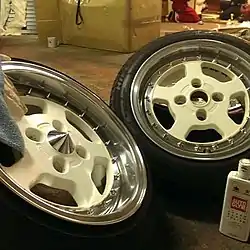
Wheel spikes are pointy protrusions attached to the rims or hubcaps of vehicles, most commonly cars and semi trucks. Most wheel spikes sold are made out of plastic painted to mimic metal, and are meant mostly as novelty items.[1][2][3] The safety and legality of wheel spikes has been often questioned, and they may constitute a traffic violation in some jurisdictions.[4]
Overview
Wheel spikes attached to the hubcaps of semi trucks are essentially stylized versions of plastic lug nut covers, which are meant to offer protection from rusting, and have more common round and flat counterparts.[1][2] Some wheel spikes applied to cars, known as "swangers," are much larger and longer and are permanently attached to the rims, and usually command much higher prices, from US$4,500 to US$10,000.[5][6]
Wheel spikes are commonly associated with the post-apocalyptic franchise Mad Max, where many characters have spikes in the wheels of their vehicles, which serve both to attack and defend against other vehicles.[1][7][8]
Legality
Wheel spikes often cause controversy due to their menacing appearance, despite most of them being made out of plastic and being easily removed or broken off. However, they may still cause injuries to pedestrians and cyclists, and may break laws regarding maximum vehicle width.[1][2] Some private transport companies may prohibit drivers from attaching wheel spikes to the wheels of company-owned vehicles to avoid a negative public image.[4]
Wheel spikes and other "projections on face of wheels" are prohibited in Hawaii since 2016.[9] In the state of Washington, the Revised Code of Washington prohibits "wheel nuts, hub caps or wheel discs [...] which: (a) incorporate winged projections; or (b) constitute a hazard to pedestrians and cyclists."[2] A bill proposed in the New York State Senate in 2015 intended to ban "dangerous wheels," defined as sharp wheel accessories that extend over 2 inches (5.08 centimeters).[10] Other US states may prohibit wheel spikes only if they extend the width of the vehicle beyond a certain limit; in Texas, it is 8 feet (2.4 meters) for passenger cars,[6] and in Florida, the limit is 8.5 feet (2.6 meters).[3] In the Australian state of Victoria, fitting vehicles with "any protruding object that is likely to increase the risk of bodily injury" is punishable with a AU$379 fine, and wheel spikes may also increase the width of a vehicle beyond the legal limit of 2.5 meters (8.2 feet).[8]
See also
- Scythed chariot – An ancient, military counterpart.
References
- 1 2 3 4 Richards, Gary (2013-12-06). "Roadshow: Scary hubcap spikes are harmless". East Bay Times. Retrieved 2022-06-27.
- 1 2 3 4 Dahl, Doug (2019-05-27). "Are those spiky lug nuts you see on semis dangerous? Are they even legal?". The Bellingham Herald. Retrieved 2022-06-26.
- 1 2 Censullo, Meredyth (2019-06-20). "What's the point of wheel spikes?". WFLA. Retrieved 2022-06-27.
- 1 2 Roberts, Bryan M. (2017-05-10). "Are Spiked Wheel Ornaments a Safety Hazard?". The National Law Review. Retrieved 2022-06-27.
- ↑ Torchinsky, Jason (2018-03-19). "If You're Wondering What Those Ben-Hur Wheel Spikes Are And If They're Legal We're Here To Help". Jalopnik. Retrieved 2022-06-27.
- 1 2 Lee, Jenni (2018-06-26). "Exaggerated tire rims ('swangers'): Are they legal?". KHOU. Retrieved 2022-06-27.
- ↑ Tudose, Sergiu (2017-12-17). "Apocalyptic Truck Spotted Pulling Amazon Prime Trailer". Carscoops. Retrieved 2022-06-27.
- 1 2 "Outcry over 'Mad Max' truck spikes". Maribyrnong & Hobsons Bay Star Weekly. 2016-05-18. Retrieved 2022-06-27.
- ↑ "HI Rev Stat § 291-33 (2016)". Justia. Retrieved 2022-06-27.
- ↑ "NY State Senate Bill S2393". NY State Senate. 2015-10-03. Retrieved 2022-06-27.